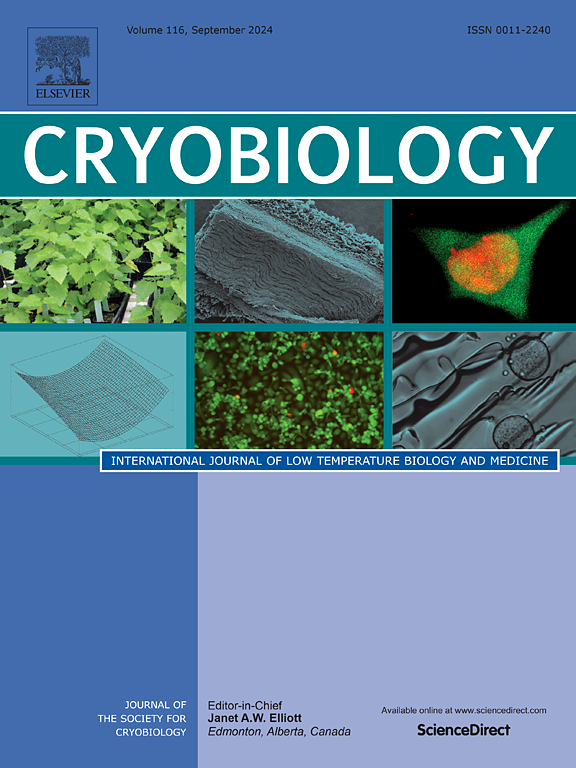外源脱落酸通过协同抗氧化防御和渗透保护剂积累增强南极苔藓的冻融耐受性。
IF 2.1
3区 生物学
Q2 BIOLOGY
引用次数: 0
摘要
脱落酸(ABA)被认为可以提高植物的冻融胁迫耐受性,但其在南极苔藓中的作用仍未得到充分的研究。因此,本研究研究了外源ABA对南极海域最广泛分布的苔藓物种之一Sanionia uncinata配子体FTST的影响。样品在控制培养条件下用10 μM ABA处理72 h,然后在-13和-16°C下进行冷冻胁迫。通过测量各种生理参数来评估aba诱导的FTST,包括离子泄漏、光合效率(Fv/Fm)、丙二醛(MDA)含量、相容溶质/渗透物(脯氨酸和总糖)和抗氧化酶活性,如超氧化物歧化酶(SOD)、过氧化氢酶(CAT)和抗坏血酸过氧化物酶(APX)。用ABA处理的配子体有效地吸收了ABA,明显比对照高20倍。施用ABA对配子体生长无明显影响,但干重/鲜重比略有提高(提高5%)。ABA显著提高了抗冻性,在两种胁迫温度下,冻害诱导的膜损伤降低了20%,缓解氧化应激,MDA积累降低了25- 34%,冻融胁迫后PSII最大量子产率(Fv/Fm)提高了6- 7%。与改善FTST并行的是,抗氧化酶、CAT和APX的活性分别提高了约11%和56%,而SOD保持不变。ABA处理也促进了渗透保护剂的积累,脯氨酸含量增加了33.5%,总可溶性糖含量增加了近一倍(99%)。这些发现提供了第一个定量证据,表明外源ABA通过协同抗氧化防御和渗透保护剂积累显著改善南极苔藓的FTST,突出了ABA在S. uncinata逆境恢复能力中的重要调节作用。本文章由计算机程序翻译,如有差异,请以英文原文为准。
Exogenous abscisic acid enhances freeze-thaw stress tolerance in Antarctic moss Sanionia uncinata through coordinated antioxidant defense and osmoprotectant accumulation
Abscisic acid (ABA) is known to improve plant freeze-thaw stress tolerance (FTST), but its role in Antarctic mosses remains largely unexplored. Accordingly, this study investigated the effects of exogenous ABA application on FTST of gametophore Sanionia uncinata, one of the most widespread moss species in maritime Antarctica. Samples were treated with 10 μM ABA for 72 h under controlled culture conditions, then subjected to freezing stress at −13 and −16 °C. Various physiological parameters were measured to assess ABA-induced FTST, including ion-leakage, photosynthetic efficiency (Fv/Fm), malondialdehyde (MDA) content, compatible solutes/osmolytes (proline and total sugars), and antioxidant enzyme activities, e.g., superoxide dismutase (SOD), catalase (CAT), and ascorbate peroxidase (APX). Gametophores treated with ABA efficiently assimilated ABA, evident by ∼20-fold higher than controls. ABA application did not impede gametophore growth but slightly increased dry weight/fresh weight ratio (5 % increase). ABA significantly improved freezing tolerance, reducing freeze-induced membrane injury by ∼20 % at both stress temperatures, alleviating oxidative stress with 25–34 % lower MDA accumulation, and enhancing PSII maximum quantum yield (Fv/Fm) by 6–7 % following freeze-thaw stress. Improved FTST was paralleled by enhanced activities of antioxidant enzymes, CAT and APX increasing by ∼11 % and 56 %, respectively, while SOD remained unchanged. ABA treatment also promoted osmoprotectant accumulation, with proline content increasing by 33.5 % and total soluble sugars nearly doubling (99 % increase). These findings provide the first quantitative evidence that exogenous ABA markedly improves FTST in an Antarctic moss through coordinated antioxidant defense and osmoprotectant accumulation, highlighting ABA as a critical regulator of stress resilience in S. uncinata.
求助全文
通过发布文献求助,成功后即可免费获取论文全文。
去求助
来源期刊

Cryobiology
生物-生理学
CiteScore
5.40
自引率
7.40%
发文量
71
审稿时长
56 days
期刊介绍:
Cryobiology: International Journal of Low Temperature Biology and Medicine publishes research articles on all aspects of low temperature biology and medicine.
Research Areas include:
• Cryoprotective additives and their pharmacological actions
• Cryosurgery
• Freeze-drying
• Freezing
• Frost hardiness in plants
• Hibernation
• Hypothermia
• Medical applications of reduced temperature
• Perfusion of organs
• All pertinent methodologies
Cryobiology is the official journal of the Society for Cryobiology.
 求助内容:
求助内容: 应助结果提醒方式:
应助结果提醒方式:


